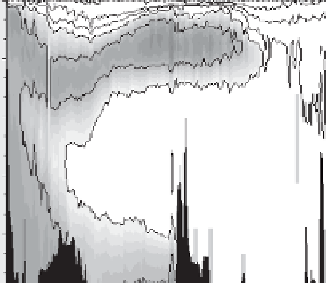Geoscience Reference
In-Depth Information
Salinity
Oxygen
South
North
0
AAIW
1000
2000
NADW
3000
4000
AABW
5000
Antarctica
Mid-Atlantic
Ridge
Iceland
Phosphate
0
Iceland
1000
2000
3000
4000
5000
Antarctica
Figure 7.17
Formation and circulation of Atlantic water. The cross-sections follow the dashed line shown
in the bottom right panel. The Gulf Stream, rich in salt because of surface evaporation in the
intertropical zone, cools in winter at high latitudes and sinks to form the North Atlantic Deep
Water (NADW). This new deep water moves southward at a depth of about 3500 m along the
coast of America. It is salty and oxygenated but depleted in nutrients, such as phosphate, by
the intense biological activity of the North Atlantic. The Antarctic Bottom Water (AABW) forms
in the Weddel Sea. This very cold water is less subjected to evaporation and receives melt water
from the Antarctic ice sheet: it is therefore less saline than NADW. It is also richer in nutrients,
especially phosphate, as it recycles old water returned from the Pacific by the circum-Antarctic
current. It is the most dense of all water masses and composes the bottom water of the main
oceans. Antarctic Intermediate Water (AAIW), diluted by rain in the southern mid latitudes, is
lighter. Figures drawn using OceanAtlas.























